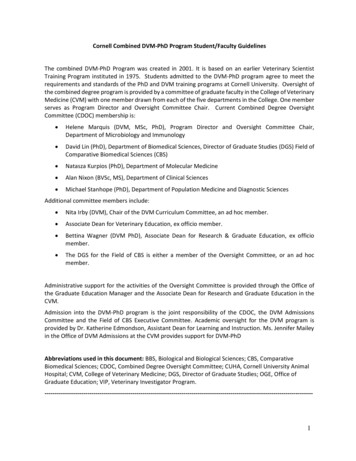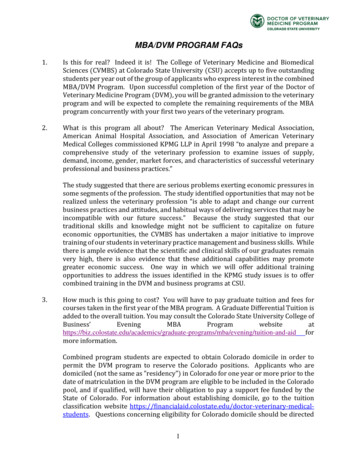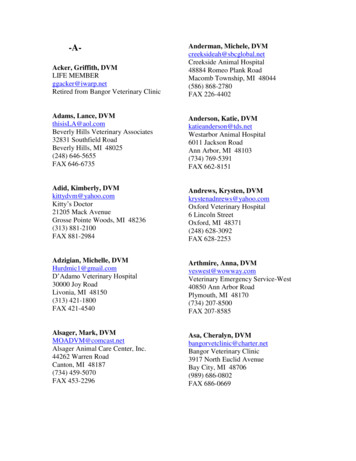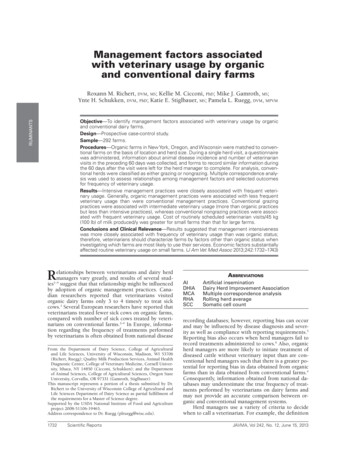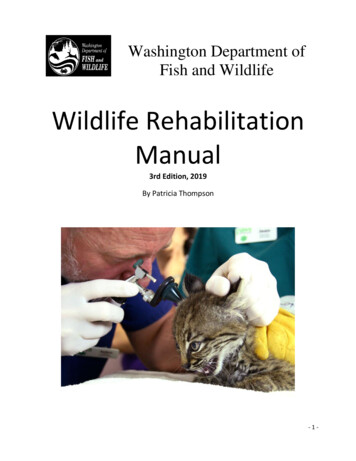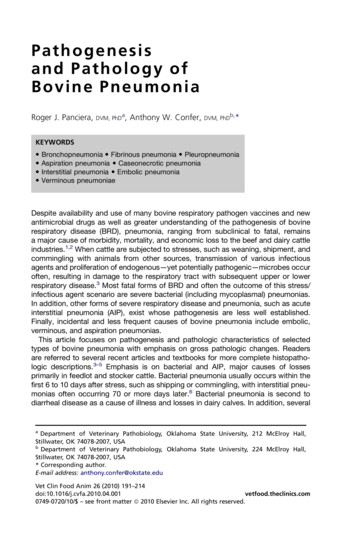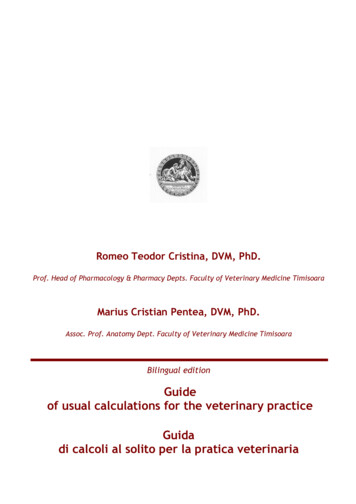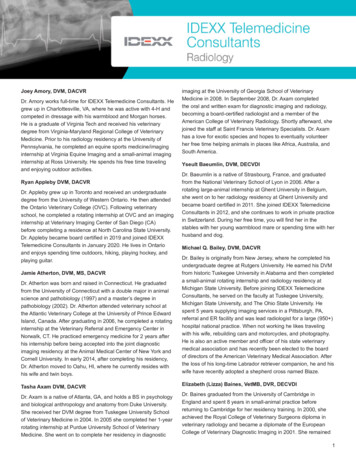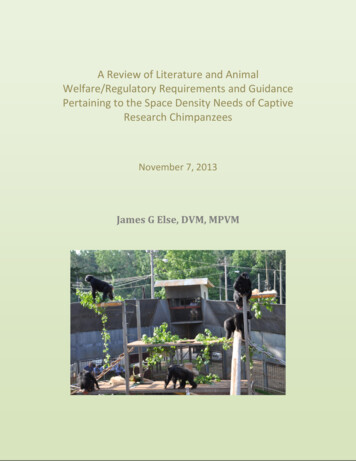
Transcription
A Review of Literature and AnimalWelfare/Regulatory Requirements and GuidancePertaining to the Space Density Needs of CaptiveResearch ChimpanzeesNovember 7, 2013James G Else, DVM, MPVM
A Review of Literature and Animal Welfare/RegulatoryRequirements and Guidance Pertaining to the Space Density Needsof Captive Research ChimpanzeesIntroductionThe Institute of Medicine (IOM) Committee on the Use of Chimpanzees inBiomedical and Behavioral Research, in its 2011 report, set forth a series ofprinciples and criteria that were to be followed for National Institutes of Health(NIH)‐funded research with chimpanzees. These were accepted by NIH, whichsubsequently assembled, and charged an NIH Council of Councils’ Working Group toprovide advice on the implementation of the principles and criteria in the IOMreport. One of the IOM Committee recommendations was that chimpanzees used inresearch “must be maintained either in ethologically appropriate physical and socialenvironments or in natural habitats”, which was based on the need to “minimizepotential sources of stress on the chimpanzee” in order to perform replicable andreliable research (IOM, 2011, p27).The Working Group delivered its report and recommendations to the Council ofCouncils in 1/2013 and included their working definition of ‘ethologicallyappropriate physical and social environments’ (EAE). After review of the report,NIH accepted all the Working Group recommendations except RecommendationEA2, which read: “The density of the primary living space of chimpanzees should beat least 1,000 ft2 (93 m2). Therefore the minimum outdoor enclosure size for a groupof 7 animals should be 7,000 ft2 (651m2)” (WG Report, 2013, p3). NIH decided toreview available data to clarify the minimum space density needed to provide anEAE for captive research chimpanzees. This document forms a part of that review.Scope of Work for this report:(1) Identify and review the published literature, and write a literature review on thespace density needed to provide an ethologically appropriate physical and socialenvironment (EAE) for captive chimpanzees in a research environment.(2) Identify, review, and summarize relevant parts of published U.S. regulations andrequirements.As guidance in the performance of this review, 5 questions were listed under theScope of Work, which were expected inform the review of space density needs forcaptive research chimpanzees:(1) What is the minimum space density that promotes species‐typical behavior ofthe captive chimpanzee and what is the evidence in support of this answer?
(2) What criteria are appropriate for determining the type(s) of enclosures tosurround the space (e.g., moats, walls, primadomes)?(3) Do the space density needs of captive research chimpanzees participating ina protocol differ from the space density needs for captive researchchimpanzees not participating in a protocol? If so, how do these needs varyand what is the rationale?(4) Is the space density influenced by special requirements/facilities that arenecessary to conduct research?(5) What alternatives exist for providing and accomplishing the minimum spacedensity, e.g., rotation schedule through larger enclosures?U.S. Regulations and Requirements Relevant to CaptiveChimpanzeesThe Animal Welfare Acthttp://www.aphis.usda.gov/animal welfare/downloads/awr/awr.pdfThe Animal Welfare Act of 1966 regulates the care and use of captive animals in anumber of different situations including research. The United States Department ofAgriculture (USDA) Animal and Plant Health Inspection Service (APHIS) overseescompliance with the Act.The Act has been modified and updated several times since its adoption, includingthe addition of provisions for enhanced standards for the humane care and use oflaboratory animals, and the requirement for research facilities to set up anInstitutional Animal Care and Use Committee (IACUC).Subpart D, Section 3.80 of the Animal Welfare Regulations lists the minimum spacerequirements for the nonhuman primate (NHP) weight category that includeschimpanzees as 25 ft2 (2.32 m2) for floor area per animal, and 84 in. (213 cm.) forenclosure height (page 107). They do point out however, that many of the NHPrequirements are generic and that “the conditions appropriate for one species donot necessarily apply to another. Accordingly, the minimum specifications must beapplied in accordance with the customary and generally accepted professional andhusbandry practices considered appropriate for each species, and necessary topromote their psychological well‐being” (page 100). Coe (1992) noted that researchfacilities tend to focus on maximizing standardization and hygiene in order to meetthe standards set by the Animal Welfare Act, as administered by USDA, in contrast toZoological displays which generally present a more diverse environment thatpromotes the expression of species typical behaviors. The constraints of rigidlyenforced standards, without due consideration of basic animal needs, may be aSpace Density Literature Review: 11/07/2013 /2
factor for consideration when providing EAEs for captive chimpanzees.Public Health Service /phspol.htmInstitutions receiving support through the US Public Health Service (PHS) forresearch, testing and training involving animals must provide detaileddocumentation (“assurance”) in respect to their compliance with the “PHS Policy onHumane Care and Use of Laboratory Animals”. The NIH Office of Laboratory AnimalWelfare (OLAW) provides guidance and interpretation of the PHS Policy, andmonitors Policy compliance by participating institutions to ensure humane care anduse of animals in PHS supported activities. OLAW relies on the Guide for the Careand Use of Laboratory Animals (the Guide) in respect to issues such as animalhousing and psychological well‐being.PHS also oversees the CHIMP Act, which includes the standards of care forchimpanzees held in the federally supported sanctuary system. The Act does notspecify enclosure size, but rather stipulates that the facilities must meet USDA andPHS compliance standards. However the Act does require that the facility designshould be in accordance with the Guide, and that the “facility must be designed toprovide sufficient space and variety of natural and artificial objects to accommodatenatural activities of chimpanzees while restricting their movement and range to thedefined area” (Federal Register, 2008 ‐ page 60418).The Institutional Animal Care and Use Committeehttp://www.iacuc.orgAs stated above, the Animal Welfare Act requires U.S. Institutions to have an IACUCto review all institutional activities involving animals. The IACUC plays a major rolein ensuring that research animals are being responsibly used, and cared for in ahumane manner. The Committee is the ultimate authority and, depending upon thecircumstances and appropriate justification, can waive or impose stricter regulatoryrequirements than are listed in the Guide and Animal Welfare Act. For example,space allocations should be assessed, reviewed, and modified by the IACUC, whichshould consider performance indices (e.g., health, reproduction, growth, behavior,and use of space) (Guide, page 56).The Guide for the Care and Use of Laboratory Animalshttp://www.nap.edu/catalog.php?record id 12910The Guide contains relatively extensive discussions on animal space needs, noting“there is no ideal formula for calculating an animal’s space needs based only onbody size or weight (page 55), and that performance indices should be taken intoconsideration”. The Guide also notes that “socially housed animals should havesufficient space and structural complexity to allow them to escape aggression orhide from other animals in a pair or group” (page 55). The recommended minimumSpace Density Literature Review: 11/07/2013 /3
space requirement for adult chimpanzees housed in pairs or groups is the same asstipulated in the Animal Welfare Act ‐ 25 ft2 (2.32 m2) of floor area per animal, and84 in. (213 cm.) in height (Table 3.5, page 61).In respect to behavioral and social management, the Guide notes that animal activityincludes cognitive activity and social interaction as well as motor activity, and that“animals’ natural behavior and activity profile should be considered duringevaluation of suitable housing” (page 63). In respect to social environment the Guidenotes that appropriate social interactions among conspecifics are essential tonormal development and well‐being, and that “an understanding of species‐typicalbehavior (e.g. natural social composition, population density, ability to disperse,familiarity, and social ranking) is key to successful social housing. However concernhas been expressed about the lack of control NHPs have on their environment,including the provision of uniform levels of temperature, illumination, etc. asdictated by USDA and AAALAC standards, vs. facilities that offer gradients anddiversity (Coe, 1992).Association of Zoos and Aquariumshttp://www.aza.orgThe Association of Zoos and Aquariums (AZA) offers an accreditation program forits members who must go through an accreditation process that is similar toAAALAC. The members must be in compliance with AZA accreditation standards.However, given the diverse species covered, AZA also produces Animal CareManuals for select species, including for the chimpanzee: ‘Chimpanzee (Pantroglodytes) Care Manual’ (AZA Ape TAG, 2010). These manuals are compiled byrecognized experts, and are looked upon as “work in progress” in an evolving field.The recommendations are not necessarily mandatory, and may require adaption tothe specific needs of individual animals, and particular circumstances in eachinstitution.The Chimpanzee Care Manual’s recommended minimum exhibit size for smallgroups of chimpanzees (5 or fewer individuals) is: “indoor and outdoor space of atleast 2000 ft2 (185 m2), and usable vertical heights of over 20ft (6.1m)” (page 16).For larger groups, there should be at least “an additional 1000 ft2 (92.9 m2) forevery additional individual over a group size of 5” (page 16). Following theseguidelines, a group of 7 chimpanzees would require a combined indoor and outdoorspace of at least 4000 ft2.Literature Review on Minimum Space Density Needed to ProvideEthologically Appropriate Environments:All literature reviewed in preparation for this report is listed in Appendix A:Literature Review, and those cited in the actual report are also listed underSpace Density Literature Review: 11/07/2013 /4
References, at the end of this report. Every effort has been made to cite the mainpublications that summarize current research relating to the issues identified in theScope of Work, as well as to represent the varying different perspectives held byexperts working with both captive and wild chimpanzees.Background to Recommendation EA2In their 2013 report, the Working Group defined the IOM Committee term“ethologically appropriate physical and social environments” as “environments thatnot only allow but importantly, promote the full range of natural chimpanzeebehaviors” (p. 13). The definition was a product of extensive deliberations,including visiting facilities and sanctuaries maintaining chimpanzees, andinterviewing experts on ethologically appropriate environments (WG Report, 2013,p. 61). The Working Group noted that: “In the tradition of modern ethology, thebehavioral repertoire of free‐ranging wild chimpanzees is used as the model, or goldstandard, toward which facility management should aspire when developing captiveenvironments.” (p. 20), and therefore “The environment and behavior of wildchimpanzees must be understood before determining how to recapitulate the mostimportant aspects of the natural behavioral repertoire of chimpanzees in captivesettings” (p. 20).In defining ‘ethologically appropriate social and physical environments’ (alsoreferred to as ‘ethologically appropriate environments’, or EAE), the Working Groupnoted that “chimpanzees in the wild live in large fission‐fusion communities”(p. 20),and that “daily travel is an essential aspect of chimpanzee life” (p. 21). Theirrecommendation EA2, on the minimum density of the primary living space, wasprefaced by the statement: “The space available to captive chimpanzees should belarge enough to support their complex social structures and sufficiently dense toallow functional subgroup behaviors. More specifically, spaces should be largeenough for chimpanzees to demonstrate their natural tendencies to range, travel,patrol, and separate from their social group completely when necessary.” (WGReport, p. 22).1. What is the minimum space density that promotes species‐typical behaviorof the captive chimpanzee and what is the evidence in support of this answer?This review has demonstrated that there is little published literature containingquantitative scientific data that can be used to support a determination of theminimum space density (horizontal surface area per animal) needed to provide anEAE for captive chimpanzees. Furthermore, other aspects of enclosure design, suchas complexity and vertical height, are considered by many to be more importantthan space density in respect to chimpanzee well‐being and the promotion ofspecies specific behavior (Wilson, 1982, Hosey, 2005, Morgan and Tromberg, 2007).Space Density Literature Review: 11/07/2013 /5
Given the emphasis placed by the IOM Committee and the Working Group onproviding for the replication of wild chimpanzee behavior in the management ofcaptive chimpanzees, a brief review of current literature on relevant wildchimpanzee behavior is provided below. Additionally, a brief review of variouscaptive chimpanzee behaviors monitored by investigators as indicators ofpsychological well‐being is also included.Chimpanzee behavior in the wildReplication of wild chimpanzee behavior in captive populations is a commonly usedyardstick in assessing chimpanzee well‐being in captivity (Wrangham, 1992), andwas referred to by the NIH Working Group (2013) “as a model, or gold standard,toward which facility management should aspire when developing captiveenvironments”. The Working Group definition of an EAE is one that would “promotethe full range of natural chimpanzee behaviors”. However a number of investigatorsdo not consider the full range of wild chimpanzee behaviors, including many ofthose reflected in a ‘fission‐fusion society’, to be necessary or desirable in captivepopulations. Wrangham (1992) notes that “normal chimpanzee behavior, i.e.behavior in the wild, is not always necessarily desirable in captivity because itincludes responses to environmental hardships, including food shortages, predationattempts, disease, and climatic extremes, as well as competitive and occasionallyviolent social behavior.”Wild chimpanzees’ propensity to live in fission‐fusion societies, whose membersform temporary parties that vary in size and composition, is a frequently referencedspecies typical behavior (Nishida, 1968). This social strategy helps balance theadvantages and disadvantages of group living, by allowing flexible responses ofgroup size to external conditions, while at the same time retaining group stability(Lehmann and Boesch, 2004).Fission‐fusion in chimpanzees in the wild is reported to be driven by externalfactors such as food availability (they tend to fragment during times of food scarcityand coalesce into larger groups in times of good food availability – Chapman &Chapman, 2000; Chapman et al., 1995; Symington, 1990; Mitani et al., 2002;Anderson et al., 2002), reproduction (formation of large groups when a female is inestrous – Boesch & Boesch‐Acherman, 2000; Anderson et al., 2002), and perceivedthreats from neighboring troops (leading to aggressive territorial behavior andpatrols (Goodall, 1986; Boesch & Boesch‐Acherman, 2000). However, as dictated byvarious U.S. regulations and requirements, chimpanzees in captivity do notexperience food shortages or predation, and disease and climate are well controlled.Furthermore, it would be unwise to encourage some chimpanzee fission‐fusionsociety behaviors in a captive environment, due to their potential dire consequences(Wrangham, 1992). Examples include territorial behavior and patrols where:“Lethal intergroup aggression is a characteristic feature of chimpanzee territorialbehavior” (Wilson and Wrangham, 2003). Likewise, other behaviors such as fissionduring food scarcity (Chapman & Chapman, 2000; Chapman et al., 1995; Symington,Space Density Literature Review: 11/07/2013 /6
1990) have limited relevance to captive chimpanzees, as food cannot be withheld(Animal Welfare Act, 2008).The findings of other studies in West Africa may throw light on the applicability orotherwise, of some other aspects of wild chimpanzee fission‐fusion behavior topopulations of captive chimpanzees. Lehmann and Boesch (2004) analyzed theextent to which fission‐fusion patterns are influenced by changes in demographicvariables like community size and composition of the chimpanzee groups. Data werecollected from a habituated chimpanzee group in Tai Forest, Cote d’Ivoire over a 10‐year period, during which time the group decreased in size from 51 to 21individuals, and the number of males decreased from 9 to 2. While the communitysize declined during this period, ecological parameters such as food availability andpredation pressure remained relatively constant (Lehmann and Boesch, 2003). Asthe community (total group size) decreased in size there was greater group stability,an increased cohesiveness between the sexes and a reduction in fission‐fusionbehavior, leading the authors to conclude that, “small communities are morecohesive and have a less flexible fission‐fusion system”. Essentially all captiveresearch chimpanzee groups would be classified as “small communities”, whichdraws into question the relevance of fission‐fusion systems to captive chimpanzees.Similar findings were observed in another long‐term study in Bossau, Guinea. Herean isolated chimpanzee group has been studied for 26 years, during which time thegroup size has remained relatively stable, at approximately 20 individuals, andfission fusion does not exist (Sugiyama, 2004). The chimpanzee group’s homeranges is restricted in size due to agricultural development on the periphery, buthas a relatively rich and constant food supply, and there are no neighboringchimpanzee groups, nor predators (Sugiyama, 1999 and 2004). The physicalcharacteristics (small, relatively stable group) and environmental conditions(restricted range, constant food supply, and no threats from the outside) of thispopulation of animals are remarkably similar to the captive situation, thus theapparent consequential lack of fission‐fusion behavior is of interest.Chimpanzee behavior in captivityObserving levels of select chimpanzee normal (species‐typical) andabnormal/stereotypical behaviors is an essential tool in the estimation of minimumspace densities needed for an EAE for captive chimpanzees. For example, changes innormal chimpanzee social behaviors, such as play, and affiliative, agonistic andsubmissive behaviors, may be used to indicate relative states of well‐being, anxiety,and social tension (Aureli and de Waal, 1997; Clarke et al, 1982; Ross et al., 2011b).Agonism in captive chimpanzees is influenced by many factors, including lack ofspace and inability to escape from others, contributing to the general pattern ofgreater aggression in captive than in wild groups (Bloomsmith and Baker, 2001).Vocalizations from neighboring groups of chimpanzees (neighbor effect) are asignificant stressor, eliciting anxiety from the increased risk of intragroupSpace Density Literature Review: 11/07/2013 /7
aggression (Baker and Aureli, 1997, Aureli et al., 2001), thus should be avoidedwhere possible.Abnormal or stereotypic behaviors among captive animals are generally defined asthose that are atypical of wild‐living individuals (Birkett and Newton‐Fisher, 2011),and generally indicate physical or psychological distress (Fritz and Howell, 1993). Anumber of investigators have reported significant declines in stereotypic behaviorsin captive chimpanzees when they are provided with an improved environment, forexample enhanced social and physical complexity (Berkson et al., 1963; Nadler andHerndon, 1992; Birkett and Newton‐Fisher, 2011). Thus a decline in abnormalbehaviors may be an indicator of a more EAE, but the empirical data to link tominimum space density is lacking.Some of the normal and abnormal chimpanzee behaviors frequently monitored toassess captive chimpanzee well‐being (in many cases resulting from changes inenclosure design and characteristics or, in some cases, space density) are welldescribed in the literature and cited below: agonistic such as (hooting, bluff, charge, fighting, biting) and submissive(grinning, hunching) behaviors (Aureli and de Waal, 1997; Clarke et al, 1982;Ross et al., 2011b) afilliative behaviors such as allogroming and play (Aureli and de Waal, 1997;Martin, 2005) activity and exploration (Ross et al., 2011b; Clarke et al., 1982; Jensvold et al.,2001), displacement activities which may indicate anxiety and social stress.Examples include self‐grooming; self–scratching and yawning (Aureli and deWaal, 1997; Baker and Aureli, 1997) stereotypic behaviors generally indicate physical or psychological distress.Examples include pacing, coprophagy, rocking, regurgitation, spitting, etc.)(Fritz and Howell, 1993; Goff et al., 1994; Birkett and Newton‐Fisher, 2011)The impact of enclosure size and animal density on chimpanzee behavior.Although there is a wealth of published literature on captive chimpanzee behaviorand well‐being in various enclosures, relatively few studies include detailed spacedensity data, and an even smaller subset have used space density as a variable.However, Ross et al. (2011b) do report a series of behavioral data sets, aimed atidentifying positive and negative behavioral changes resulting from movingchimpanzees from a traditional hardscape setting, to a modern, more spaciousnaturalistic environment. He compares behavioral data sets collected from 2001‐02for 5 chimpanzees, when they were housed in a 73 m2 indoor enclosure at a spacedensity of 12.2 m2/individual (GAH facility – enclosure dimensions and spacedensity data from Ross et al. 2009), with data collected from 2004‐07 when thesame 5 animals occupied a new, naturalistic facility (RCAA), an indoor/outdoorenclosure which provided a combined space density of 36.9 m2/individual (RCAASpace Density Literature Review: 11/07/2013 /8
enclosure space density data from Ross et al. 2009). Both the GAH and the RCAAindoor enclosures had substantial vertical height and spatial complexity, and RCAAcomparative behavioral data was only collected when the chimpanzees did not haveaccess to the outdoor area (indoor space density was 14.5 m2/individual) to providea more equal comparison. The authors did not find significant indications ofimproved chimpanzee behavior and welfare subsequent to the move, a fact theyattributed to the successful design attributes of original (GAH) enclosure, and theypostulated: “We may predict the most robust effects of increasing usable space tooccur when individuals are maintained in an enclosure at the minimal sizethreshold. Once this threshold is crossed – as was the case in GAH – we would thenexpect diminishing behavioral and welfare benefits with further increases” (Ross etal., 2011b: p. 113). A similar observation was made by Wilson (1982), who notedthat increasing space beyond that required, may have little effect on activity.Other studies that focus more on aggression, and that report quantitative spacedensity data, include Aureli and De Waal (1997) who studied the effects of short‐term high population density in 45 chimpanzees housed in 5 groups at the YerkesPrimate Center. The “control” indoor/outdoor density was 5.5 m2 per individual.When animals were locked into “high density” (2 m2/individual) indoor enclosureduring cold weather they exhibited (behaviorally) increased social tension/anxiety,but also a general decrease in social activities, including antagonistic behavior,thought to be an inhibition strategy to reduce opportunities for conflict when inter‐individual distances are decreased”. Such a strategy was thought to be effective onlyfor short time periods.Nieuwenhuijsen and de Waal (1982) reported earlier on a group of 22 chimpanzeesheld at Arnheim Zoo in an outdoor summer enclosure of 7,000 m2 (318m2/individual) and an indoor enclosure of 432 m2 (19.6 m2/individual, where thechimpanzees resided during the winter. Increased aggressiveness during the wintermonths was noted, although the aggression frequencies did not rise by a very highfactor, and they did not find any increase in intensity of aggressive acts due tocrowding. There was also a reduction in vertical structures and complexity in theindoor enclosure, which is a significant confounding variable (see environmentalcomplexity and vertical height section below), but again the chimpanzees appearedto behaviorally adapt to increased density through a reduction of intense agonisticinteractions.Caws and Aureli (2003), studying the effect of reduced escape opportunities in alarge group of chimpanzees at the Chester Zoo, suggested that chimpanzees mayadopt a selective inhibition strategy when escape opportunities are limited, andspeculated that the inhibition of aggressive tendency may be related to howchimpanzees in a captive environment respond to the natural challenges bysubgroup membership changes, characteristic of their fission‐fusion organization.As such, the inhibition of aggression in select situations may well be a normalspecies typical behavior.Space Density Literature Review: 11/07/2013 /9
Jensvold et al. (2001) compared the effect of enclosure size and complexity onchimpanzee behavior when five chimpanzees were moved to a new 587m2indoor/outdoor enclosure with an exceptionally high degree of environmentalcomplexity, and introduced the concept of ‘climbable surface area’, which underliesthe importance of considering the physical complexity of enclosures as well assurface space. While not defining the term, nor providing any calculation details, sheasserted that the climbable surface area of the new enclosure was more than 7‐foldthat of the actual surface area.Ross and Lukas (2002) reported that when two small groups of chimpanzees werecombined to create a more complex multi‐male group, social play and proximityincreased significantly, despite the fact that proportionately more enclosure spacehad been made available. This could indicate that (minimum) space densityrequirements do not increase linearly with increased group size and socialcomplexity.AZA accreditation requires indoor and outdoor space of at least 2000 ft2 (185 m2)for up to 5 chimpanzees (or 400 ft2/18.6m2 per individual), and then an additional1000 ft2 (92.9 m2) for every additional individual (AZA Ape TAG, 2010). Though notstated it might be assumed that increased space density requirement for theadditional individuals was to accommodate the projected need to travel and escapeas the group increased in size and complexity. However, from much of the literaturereviewed it would appear that the same effect could be accomplished through theprovision of a high level of enclosure complexity, including adequate above groundsurface area, multiple visual barriers and escape opportunities.Space preferences and useMeasuring how animals choose to utilize their space is a common method todetermine both positive and negative aspects of captive environments (Ross et al.,2009). Although space use is influenced not only by environmental preferences, butalso by social and biological factors (Ross et al., 2009; Bettinger et al., 1994),studying the way in which animals use and choose different features in theirenclosure is a valuable way to measure the appropriateness of their environmentand maximize animal welfare (Ross et al., 2009).Effective use of space provided for captive chimpanzees is an issue that needs to beconsidered in conjunction with space density. A number of studies as well asopportunistic observations indicate that, even in relatively large compounds,chimpanzees tend to preferentially utilize specific enclosure attributes such asperimeter walls and climbing structures, and favor doorways and corners (Clarke etal., 1982; Traylor‐Holzer and Fritz, 1985; Ross et al, 2009) and essentially all spaceuse studies report significant underutilization of open space. The ideal is for thechimpanzees to use all available space evenly (Traylor‐Holzer & Fritz, 1985; Ross etal., 2009), but this is rarely the case and most if not all space use studies reportSpace Density Literature Review: 11/07/2013 /10
marked disparities (Ross et al., 2009 and 2011a; Ross and Lukas, 2006; Stoinski etal., 2001; Traylor‐Holzer & Fritz, 1985; Bettinger et al., 1994).Studies of space use patterns can reveal the environmental preferences of captiveprimates and can be useful for establishing detailed housing guidelines to assurehousing does not negatively impact psychological well‐being (Goff et al., 1994). Rossand Lukas (2006) studied patterns of space use by 6 chimpanzees at Lincoln ParkZoo and then incorporated this information in the design of a new great ape exhibit.Follow up space use studies showed that the chimpanzees utilized all areas of thenew facility more evenly than in the older previous exhibit (Ross et al., 2009).Environmental complexity and vertical spaceMorgan and Tromberg (2007) in their comprehensive review the various causes ofstress in captive animals concludes that “it may well be that it is not the quantity ofspace available to the animal which is important, but its quality – what it affordsanimals (including great apes) in the way of behavioral opportunity”. They highlightthe i
requirements than are listed in the Guide and Animal Welfare Act. For example, space allocations should be assessed, reviewed, and modified by the IACUC, which should consider performance indices (e.g., health, reproduction, growth, behavior, and use of space) (Guide, page 56). TheGuide for the Care and Use of Laboratory Animals
